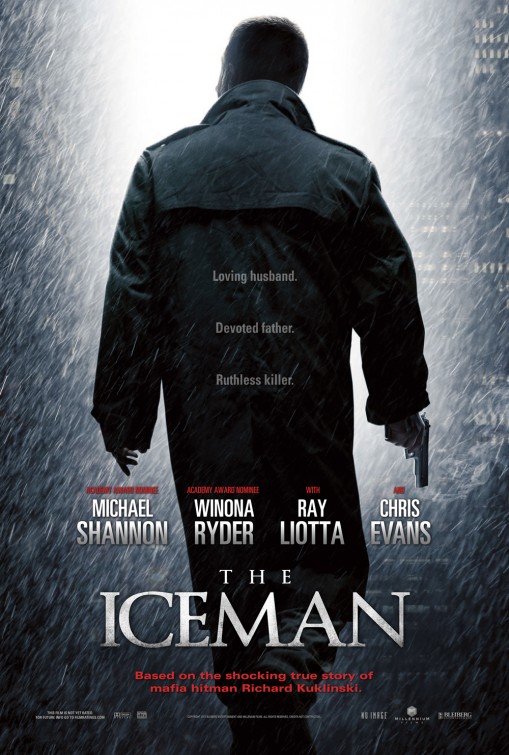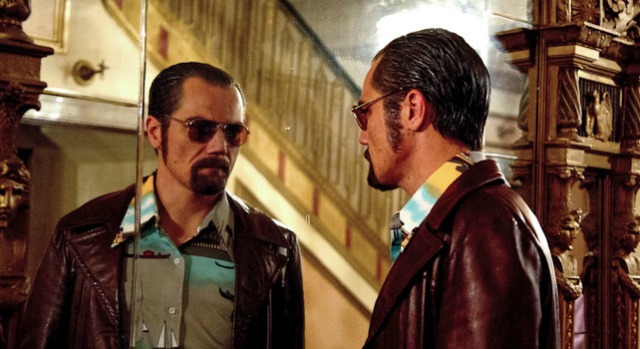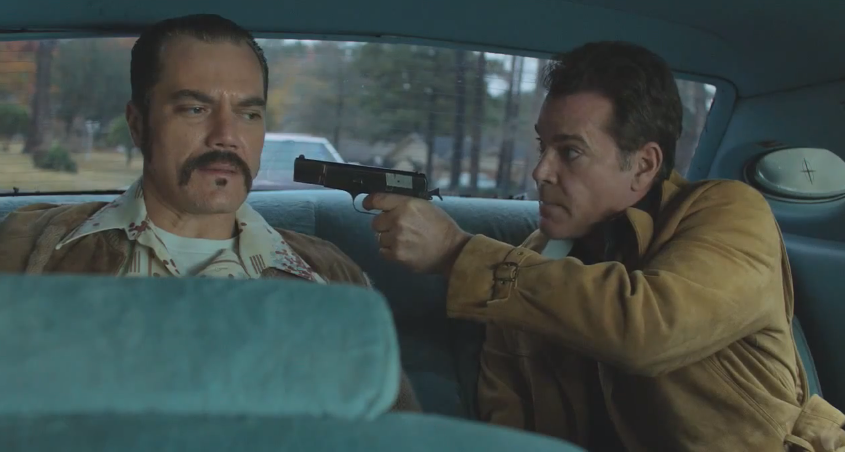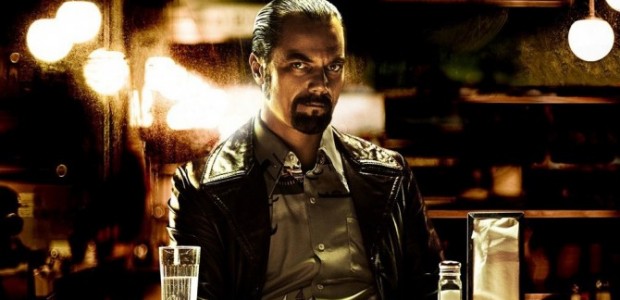
The true-crime film exists in an unusual space in current American genre cinema. More than most film genres, it must compete fiercely against television for an audience’s attention. Beyond the History Channel and Court TV and Lifetime, there is the nightly news, and the spate of excellent documentaries on HBO (something we’ll get back to in a minute). Why travel to the theater when you can just flip on the TV?
There are many ways for a movie to attack this question. Some, like 2007’s AMERICAN GANGSTER (telling the story of drug kingpins Frank Lucas and Nicky Barnes), 2009’s PUBLIC ENEMIES (the Dillinger gang), 2011’s KILL THE IRISHMAN (Danny Greene), or 2012’s LAWLESS (the Bondurant bootleggers), take the period approach, enlisting top-flight Hollywood costumers and production designers. Some are ponderous. Some are fleetingly thrilling. Many end on a down note. Others, such as 2009’s I LOVE YOU PHILLIP MORRIS (Steven Jay Russell) and THE INFORMANT! (Mark Whitacre) and 2012’s BERNIE (Bernie Tiede), choose a more disarmingly upbeat tone to offset some of the criminality being depicted. Some movies heavily fictionalize true events, such as 2006’s THE DEPARTED (Whitey Bulger), while some, like 2010’s THE TOWN or 2012’s KILLING THEM SOFTLY, only feel like they do. Only a few true-crime movies in the last couple decades have approached the level of masterpiece. 2007’s ZODIAC is arguably one of them.

All of these movies tend to have two things in common: For one thing, they all are attempting to bloom inside the long shadow cast by a towering example of the genre, 1990’s GOODFELLAS. Some movies are more obviously indebted to Martin Scorsese’s classic film about the Lucchese crime family of New York, such as 2001’s BLOW and 2003’s WONDERLAND (itself indebted to 1997’s BOOGIE NIGHTS, which was influenced by GOODFELLAS) (yikes!). We are living in an era of ambitious younger filmmakers who grew up watching GOODFELLAS have come of age, who are getting a shot, and who now want to try their own hand at a sweeping true-crime epic. This is not a knock at these young filmmakers. They have excellent taste! But it’s not easy to make an energetic, heavy-impact, rock-n-roll barnburner about several decades’ worth of actual history. As William Goldman has said, the passage of time is one thing movies generally don’t do so well, certainly not compared to books or novels. GOODFELLAS is the kind of exception that proves the rule, which is why so many filmmakers look to it for inspiration, and why so many people like me cite it as a benchmark when talking about newer films.
The other thing that all of the movies I cited above have in common, with each other and with many others I haven’t mentioned, the one thing movies can provide that no true-crime documentary or recreation on the small screen really can, is star power. Every once in a while you’ll get a “Rob Lowe as Drew Peterson,” but that’s not much compared to what you get on the big screen from Denzel Washington, Johnny Depp, Ray Stevenson, Tom Hardy, Jim Carrey, Matt Damon. A star can immediately bring an audience into the unsavory world of a true-crime film. Often it’s as a means to relate to the events unfolding. You’re less quick to judge a character like Frank Lucas, a thief and murderer, if he’s played by a guy you love as much as Denzel. Less frequently, a star will take on this genre to subvert their every-day persona, which can be powerful if done properly. See again the example of Denzel. And very occasionally, the true-crime genre can provide a role for an actor that is the perfect vehicle to expand his (or her) pre-existing stable of talents. By playing a flawed, damaged, or deplorable character, an actor can tap into reserves of intensity and menace and really let fly. It can be liberating for the actor and revelatory for the audience.
All of which, finally, leads us to the case of Michael Shannon and THE ICEMAN.

THE ICEMAN is a dramatized rendition of the true story of Richard Kuklinski, a New Jersey man of Polish and Irish descent who became a brutal and prolific hitman for the Italian mob. The Kuklinski story is striking in its scope of epic cruelty. He killed an unknown number of people – at least a hundred – and was unrepentant for his crimes. The fact that he showed no remorse for an unimaginable career of cold-blooded murder makes it easy to simply label Kuklinski as a monster; however, the story is all the more mystifying because he was a monogamist and a suburban family man, maintaining a marriage for decades and fathering three children. The movie whitewashes Kuklinski’s abusiveness to his wife Barbara (Deborah in the movie) and their kids, but nonetheless its depiction of his perplexing double-life feels thematically accurate. If you feel you’ve been sleeping too well lately and would like to give yourself some sleepless nights, check out HBO’s famous documentary, “The Iceman Tapes: Conversations With a Killer,” where Kuklinski is interviewed on camera, calmly recounting the various murders he committed. Another detail the movie glides over, which is explored in depth in Phillip Carlo’s book The Ice Man: Confessions Of A Mafia Contract Killer (again, a first-class sleep-ender), is that Kuklinski was already weekending as a serial killer before Roy DeMeo and the mob mentored him in. He was a killer. That was what he did. Falling in with the mob was like a perfect storm. Kuklinski experimented with his methodology — using guns, knives, his own bare hands, poisons, and even crossbows — which is one reason he eluded capture for so long. He was nicknamed “The Iceman” for his practice of freezing his victims so that authorities would have more difficulty establishing a time of death. After many years, the police finally took him alive, and until his death in prison, Kuklinski was a cooperative interview subject. There is a LOT of footage of this man explaining his heinous acts.
I’m not sure how much of this footage Michael Shannon studied beforehand, and he certainly doesn’t look much like the real Richard Kuklinski (who more resembled a kaiju version of David Ogden Stiers from M*A*S*H), but you will have to look far and wide to find a more thorough and unsettling instance of a supremely talented actor inhabiting of a real-life murderer. It’s a truly volcanic performance, or the iceberg version of a volcano anyway.
Michael Shannon is a journeyman actor who has steadily become a widely-renowned character actor, to the point where he’s about to play the main villain (General Zod) in the upcoming Superman film MAN OF STEEL. He’s a major talent. But it’s worth noting that I didn’t like him at first. He was so convincing as a vile lowlife in 8 MILE and BAD BOYS 2, the first movies I saw him in, that I would have been happy to never see his face again. Now THAT’S a bold actor! Too many of them want to be liked. This is a guy who’s willing to push an audience’s disgust in honest directions. My fondness for Shannon’s unique presence increased with under-seen movies such as SHOTGUN STORIES and BEFORE THE DEVIL KNOWS YOU’RE DEAD. He was nominated for an Academy Award for his role in REVOLUTIONARY ROAD, and he should have won one for his unforgettable work in TAKE SHELTER. He was 31 flavors of fun in PREMIUM RUSH, and now he’s back to being full-on repulsive.

College kids put posters of Ray Liotta as Henry Hill up on their walls. It’s doubtful the same will be true of Michael Shannon as Richard Kuklinski. There’s nothing charming about this guy, nor probably should there be. The first scene of THE ICEMAN is a lengthy one, a first date between Richard and his eventual wife, Deborah (Winona Ryder), and it’s important to start there because it’s the only time in the movie Kuklinski is remotely endearing. His jokes aren’t good but she seems to like him, and she’s sweet enough, so now as an audience we’re prepared to go with them for the rest of this movie. But Michael Shannon as Richard Kuklinski is a coiled snake, a Great Stone Face with lethal venom in his circulation, a Buster Keaton of killing folks. When a sour jerk in a pool hall disrespects Deborah, Richard cuts his throat, but there’s no visible passion in it. To him, it just appears to be the appropriate action to take. There’s almost an OCD feel to his process. The only outwardly emotional moments Shannon-as-Kuklinski has in the movie is when he’s dealing with threats to his family, especially when those threats are coming from himself. The movie brilliantly shows that the only internal conflict this cold-blooded killer feels is when he is struggling with the messy process of rejoining the world of living humans, the incongruity of the love and devotion he feels for his wife and kids when he feels literally nothing for anyone else.
Thanks to Michael Shannon’s tremendous performance, Richard Kuklinski is a truly repugnant character but an absolutely fascinating one. When he’s on screen, your eyes are reluctant to leave him. The supporting cast surrounding him is well-chosen. Winona Ryder struggles with the Jersey accent, but she provides the sweetness and vulnerability that counter-balances the career criminal she unwittingly married. She recalls the metaphorical image of the canary in a coalmine. Ray Liotta plays Roy DeMeo. As in KILLING THEM SOFTLY, his appearance recalls his role in GOODFELLAS, and as in that movie, THE ICEMAN wisely embraces the association. Ray Liotta makes you think of GOODFELLAS but Michael Shannon reminds you that this is a very different movie. Imagine if Joe Pesci’s character were the centerpiece, or if Henry Hill had been in witness protection and nobody noticed he was killing people.
A barely-recognizable Chris Evans shows up as Robert Pronge, like Richard Kuklinski a real-life hitman for the Mafia, who drove a Mister Softee truck as a cover for his mobile murder practice. Evans is hardly as convincingly malevolent as Shannon is, but if his starpower brings people to this movie that’s a good thing. Likewise, a very famous actor appears for a one-scene cameo. Besides being one of the film’s producers, it’s clear he took the role because it’s an indelible scene. (Richard Kuklinski told a story of showing up at the home of one of his targets, who began praying for his life. Kuklinski told the man to pray another minute and see if God could stop Kuklinski from killing him. It’s the kind of calculated heartlessness perfectly encapsulates the kind of person Kuklinski was.) A completely-unrecognizable Stephen Dorff is surprisingly spooky as Richard’s only brother, in prison for life for murdering a young girl, and a hilariously-recognizable but thoroughly-effective David Schwimmer shows up as a gutless underling with a strangely believable bond with Liotta’s character. Again, it’s a good cast, but no one draws much attention away from the centerpiece.
Michael Shannon is the focus of this movie’s attention. That makes sense. It’s a monster movie. He’s the monster. There are two true-crime films I have seen that qualify as horror films. One is 1976’s THE TOWN THAT DREADED SUNDOWN. The other is 1990’s HENRY: PORTRAIT OF A SERIAL KILLER.
THE ICEMAN is now a third.
It’s a creative masterstroke to shoot a true-crime movie like a J-horror GOODFELLAS. Director Ariel Vromen is someone to watch. His script for THE ICEMAN, co-written with Morgan Land, effectively condenses a story spanning several decades, maintaining audience interest on an ultimately-unknowable protagonist. Working with cinematographer Bobby Bukowski, Vromen makes the look of the film striking but perfectly matched to its subject matter. The world of the Kuklinski home favors a warmer palette, whereas the scenes of the Ice Man at work are ruled by colder colors, metallic blues and grays. When the two halves of Richard’s life begin to merge, so too does the appearance of the film. Also of note is the tremendous production design by Nathan Amondson. This film could not have had a huge budget, yet it spans multiple locations without once dropping the illusion that these places are where these events really happened. The thoroughness of the period detail is impressive. It’s stuff most people don’t think they notice when they sit down to watch a movie, but if it wasn’t done so well, you would. Creating a believable environment to surround the actors is what leads to believable performances. If this crew hadn’t done such stellar work, it’s unlikely this movie could have produced that Michael Shannon performance, which really is one for the ages.
THE ICEMAN is one of the very few movies to invoke the memory of GOODFELLAS that doesn’t suffer by comparison. It may not be quite at the level of mastery of its predecessor, but nonetheless it has an unshakeable effect. GOODFELLAS is halfway a comedy. THE ICEMAN is halfway a horror film. I felt beat up at the end of it. I think that’s the right way for a movie like this one to make you feel. It’s maybe not for me or anyone else on Earth to pass judgment on Richard Kuklinski, although if we can’t call him a bad guy, who the hell else could the bad guys be? But maybe that’s not the point. THE ICEMAN makes you hurt for Richard Kuklinski’s victims. And that makes it worthy.
@jonnyabomb
- [THE BIG QUESTION] WHAT’S YOUR FAVORITE FEMALE ENSEMBLE IN MOVIES? - July 22, 2016
- [IN THEATERS NOW] THE BOY (2016) - January 24, 2016
- Cult Movie Mania Releases Lucio Fulci Limited Edition VHS Sets - January 5, 2016
Tags: Chris Evans, Crime, Horror, Jon Abrams, Michael Shannon, Ray Liotta, True Story, Winona Ryder






No Comments